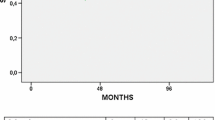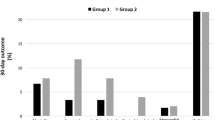Abstract.
Carotid endarterectomy (CEA) has been shown to be effective in stroke prevention in selected patients. Some studies, however, identified gender as an independent risk factor for perioperative CEA complications demonstrating an increased rate of perioperative stroke or death in women. Furthermore, contralateral internal carotid artery (ICA) occlusion has been associated with higher rates of perioperative CEA complications. Therefore, we sought to analyse the gender-specific risk of perioperative CEA complications between patients with or without contralateral ICA stenosis or occlusion. We retrospectively analysed 212 consecutive CEA patients (male = 156, Female = 56) for their gender-specific, perioperative risk of stroke, transient ischemic attack (TIA), restenosis and cardiac complications in the presence (62%) or absence (38%) of a contralateral ICA stenosis/occlusion. In women but not in men, risk of perioperative ischemic events (stroke, TIA) or re-stenosis (p = 0.036) and combined perioperative complications (ischemic events, re-stenosis or cardiac complications; 38.2 % vs. 9.1%; p = 0.028) was significantly increased in the presence of a contralateral ICA stenosis or occlusion. Furthermore, in the presence of a contralateral ICA stenosis/occlusion the number of perioperative ischemic events (p = 0.008) and combined perioperative complications (38.2 % vs. 14.3%; p = 0.006) was significantly higher in female than in male patients. Our study suggests that women with contralateral ICA stenosis or occlusion may have a significantly higher risk for perioperative CEA complications than other subgroups of CEA patients. This risk increase seems to be gender-specific and, if confirmed in larger prospective studies, may influence ICA stenosis therapy in the presence of a contralateral ICA stenosis/occlusion in female patients.
Similar content being viewed by others
References
AbuRahma AF, Robinson P, Holt SM, Herzog TA, Mowery NT (2000) Perioperative and late stroke rates of carotid endarterectomy contralateral to carotid artery occlusion: results from a randomised trial. Stroke 31:1566–1571
Ackerstaff R, Jansen C, Moll F, Vermeulen F, Hamerlijnck R, Mauser H (1995) The significance of microemboli detection by means of transcranial Doppler ultrasonography monitoring in carotid endarterectomy. J Vasc Surg 21:963–969
Adelman MA, Jacobowitz GR, Riles TS, Imparato AM, Lamparello PJ, Baumann FG, Landis R (1995) Carotid endarterectomy in the presence of a contralateral occlusion: a review of 315 cases over a 27-year experience. Cardiovasc Surg 3:307–312
Akbari CM, Pulling MC, Pomposelli FB Jr, Gibbons GW, Campbell DR, Logerfo FW (2000) Gender and carotid endarterectomy: does it matter? J Vasc Surg 31:1103–1108
Appleberg M, Cottier D, Crozier J, Graham J, Lane R (1995) Carotid endarterectomy for asymptomatic carotid artery stenosis: patients with severe bilateral disease a high risk subgroup. Aust NZJ Surg 65:160–165
Aungst M, Gahtan V, Berkowitz H, Roberts AB, Kerstein MD (1998) Carotid endarterectomy outcome is not affected in patients with a contralateral carotid artery occlusion. Am J Surg 176:30–33
Ballotta E, DaGiau G, Renon L (1999) Early and late outcomes of young patients after carotid endarterectomy. Surgery 125:581–586
Bond R, Narayan SK, Rothwell PM, Warlow CP (2002) The European Carotid Surgery Trialists’ Collaborative Group. Clinical and radiographic risk factors for operative stroke and death in the European carotid surgery trial. Eur J Vasc Endovasc Surg 2:108–116
Boontje AH (1994) Carotid endarterectomy without a temporary indwelling shunt: result and analysis of back pressure measurements. Cardiovasc Surg 2:549–553
European Carotid Surgery Trialists’ Collaborative Group (1991) MRC European Carotid Surgery Trial: interim results for symptomatic patients with severe (70–99%) or with mild (0–29 %) carotid stenosis. Lancet 337:1235–1243
Executive Committee for the Asymptomatic Carotid Atherosclerosis Study (1995) Endarterectomy for asymptomatic carotid artery stenosis. JAMA 273:1421–1428
Ferguson GG, Eliasziw M, Barr HWK, Clagett GP, Barnes RW, Wallace MC, Taylor DW, Haynes RB, Finan JW, Hachinski VC, Barnett HJM for the North American Symptomatic Carotid Endarterectomy Trial Collaborators (1999) The North American Symptomatic Carotid Endarterectomy Trial: Surgical results in 1415 patients. Stroke 30:1751–1758
Gasecki AP, Eliasziw M, Ferguson GG, Hachinski V, Barnett HJM for the North American symptomatic carotid endarterectomy trial (NASCET) group (1995) Long-term prognosis and effect of endarterectomy in patients with symptomatic severe carotid stenosis and contralateral carotid stenosis or occlusion: results from NASCET. J Neurosurg 83:778–782
Goldstein LB, Samsa GP, Matchar DB, Oddone EZ (1998) Multicenter review of preoperative risk factors for endarterectomy for asymptomatic carotid artery stenosis. Stroke 29:750–753
Gorelick PB (1999) Carotid endarterectomy—where do we draw the line? Stroke 30:1745–1750
Hamdan AD, Pomposelli FB Jr, Gibbons GW, Campbell DR, LoGerfo FW (1999) Perioperative strokes after 1001 consecutive carotid endarterectomy procedures without an electroencephalogram: incidence, mechanism and recovery. Arch Surg 134:412–415
Hertzer NR, O’Hara PJ, Mascha EJ, Krajewski LP, Sullivan TM, Beven EG (1997) Early outcome assessment for 2228 consecutive carotid endarterectomy procedures: the Cleveland Clinic experience from 1989 to 1995. J Vasc Surg 26:1–10
James DC, Hughes JD, Mills JL, Westerband A (2001) The influence of gender on complications of carotid endarterectomy. Am J Surg 182:654–657
Laman DM, Wieneke GH, Van Duijn H, Van Huffelen AC (2002) High embolic rate early after carotid endarterectomy is associated with early cerebrovascular complications, especially in women. J Vasc Surg 36:1–7
Levi CR, O’Malley HM, Fell G, Roberts AK, Hoare MC, Royle JP, Chan A, Beiles B, Chambers BR, Bladin CF, Donnan GA (1997) Transcranial Doppler detected cerebral microembolism following carotid endarterectomy: high microembolic signal loads predict postoperative cerebral ischemia. Brain 120:621–629
Mattos MA, Sumner DS, Bohannon WT, Parra J, McLafferty RB, Karch LA, Ramsey DE,Hodgson KJ (2001) Carotid endarterectomy in women—challenging the results from ACAS and NASCET. Ann Surg 234:438–446
McCrory DC, Goldstein LB, Samsa GP, Oddone EZ, Landsman PB, Moore WS, Matchar DB (1993) Predicting complications of carotid endarterectomy. Stroke 24:1285–1291
North American Symptomatic Carotid Endarterectomy Trial Collaborators (1991) Beneficial effect of carotid endarterectomy in symptomatic patients with high-grade carotid stenosis. N Engl J Med 325:445–453
Perler BA, Burdick JF, Williams GM (1992) Does contralateral internal carotid artery occlusion increase the risk of carotid endarterectomy? J Vasc Surg 16:347–352
Rothwell PM, Slattery J, Warlow CP (1996) A systematic review of the risks of stroke and death due to endarterectomy for symptomatic carotid stenosis. Stroke 27:260–265
Rothwell PM, Slattery J,Warlow CP (1997) Clinical and angiographic predictors of stroke and death from carotid endarterectomy: systematic review. BMJ 315:1571–1577
Samson RH, Showalter DP, Yunis JP (1998) Routine carotid endarterectomy without a shunt, even in the presence of a contralateral occlusion. Cardiovasc Surg 6:475–484
Sarac TP, Hertzer NR, Mascha EJ, O’Hara PJ, Krajewski LP, Clair DG, Karafa MT, Ouriel K (2002) Gender as a primary predictor of outcome after carotid endarterectomy. J Vasc Surg 35:748–753
Sternbach Y, Perler BA (2000) The influence of female gender on the outcome of carotid endarterectomy: a challenge to the ACAS findings. Surgery 127:272–275
Stork JL, Levi CR, Chambers BR, Abbott AL, Donnan GA (2002) Possible determinants of early microembolism after carotid endarterectomy. Stroke 33:2082–2085
Subramaniam P, Stary D, Scott A (1995) Carotid surgery in Northern Tasmania: a retrospective view. Aust N Z J Surg 65:480–484
Author information
Authors and Affiliations
Corresponding author
Rights and permissions
About this article
Cite this article
Weise, J., Kuschke, S. & Bähr, M. Gender-specific risk of perioperative complications in carotid endarterectomy patients with contralateral carotid artery stenosis or occlusion. J Neurol 251, 838–844 (2004). https://doi.org/10.1007/s00415-004-0438-8
Received:
Revised:
Accepted:
Issue Date:
DOI: https://doi.org/10.1007/s00415-004-0438-8




